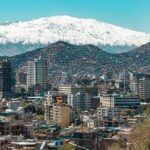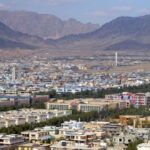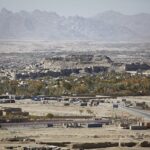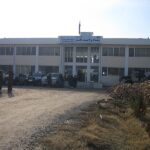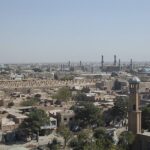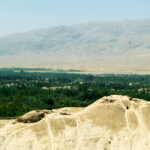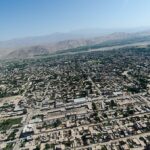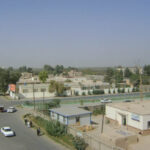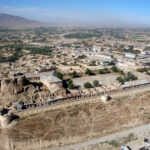Kunduz
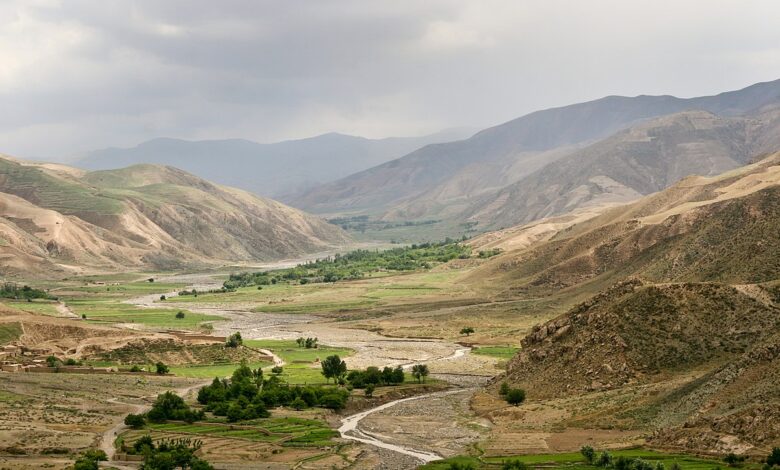
Kunduz is a city in northern Afghanistan and is the capital city of the Kunduz Province. The province is located in the northeastern part of the country and is known for its diverse ethnic and linguistic composition. The majority of the population in Kunduz is of Pashtun and Tajik ethnicities.
The capital city, Kunduz, has been the site of military operations and clashes between Afghan government forces, Taliban insurgents, and other militant groups. The province has faced security challenges and has witnessed both conflict and efforts at stabilization and development.
| ID |
|---|
| 89 |
| Name |
| Kunduz |
| State ID |
| 3900 |
| State Code |
| KDZ |
| State Name |
| Kunduz Province |
| Country ID |
| 1 |
| Country Code |
| AF |
| Country Name |
| Afghanistan |
| Latitude |
| 36.72895000 |
| Longitude |
| 68.85700000 |
| WikiData ID |
| Q108155 |
Kunduz (; Pashto: قندوز; Persian: قندوز) is a city in northern Afghanistan and the capital of Kunduz Province. The city has an estimated population of about 268,893 as of 2015, making it about the seventh largest city of Afghanistan, and the largest city in northeastern Afghanistan. Kunduz is in the historical Tokharistan region of Bactria, near the confluence of the Kunduz River with the Khanabad River. Kunduz is linked by highways with Kabul to the south, Mazar-i-Sharif to the west, and Badakhshan to the east. Kunduz is also linked with Dushanbe in Tajikistan to the north, via the Afghan dry port of Sherkhan Bandar. This city is famous in Afghanistan for its watermelon production.
As of 2015, the land use of the city (within the municipal boundary) is largely agricultural (65.8% of total area). Residential land comprises nearly half of the 'built-up' land area (48.3%) with 29,877 dwellings. Institutional land comprises 17.9% of built-up land use, given that the airport is within the municipal boundary.
Etymology
Kunduz is also sometimes spelled (romanized) as Kundûz, Qonduz, Qondûz, Konduz, Kondûz, Kondoz, or Qhunduz. The name of the city is derived from the Persian compound, kohan dež, "old/ancient fort".
History
Kunduz is the site of the ancient city of Drapsaka. It was a great centre of Buddhist learning and very prosperous during the 3rd century AD.
The city used to be called Aornos (Bactrian: οαρνο, romanized: warn) and later Walwalij or Varvaliz, a compound of the old name Warn and Bactrian: λιζο, romanized: lizo, lit. 'fortress'. The name Kuhandiz began to be used from the Timurid time.
In the 18th and 19th centuries it was the capital of an Uzbek khanate which reached its largest extent, from Balkh to the Pamir Mountains, during the reign of Murad Beg (1815–1842). Murad Beg faced the decline of his state after being defeated by Dost Mohammad Khan. After Murad's death, the khanate declined and was eventually subjugated by Afghanistan in 1859.
In the early 20th century, between 100 and 200,000 Tajiks and Uzbeks fled the conquest of their homeland by the Russian Red Army and settled in northern Afghanistan.
In the early 20th century, under the governance of Sher Khan Nashir, Kunduz became one of the wealthiest Afghan provinces. This was mainly due to Nasher's founding of the Spinzar Cotton Company, which continues to exist in post-war Afghanistan. At its peak, the Spinzar Cotton Company employed 5,000 people full time. Kunduz is the most important agricultural province which produces wheat, rice, millet, and other products and obtained the nickname of "the hive of the country."
21st century
Kunduz is the centre for the northeast provinces and was captured by the Taliban in 1997. It was the last major city held by the Taliban before its fall to US-backed Afghan Northern Alliance forces on 26 November 2001.
During the summer of 2015, the Taliban advanced and attacked the city, which resulted in a battle for control of the city against Afghan forces. Tens of thousands of inhabitants were displaced internally by the fighting. On 28 September 2015 the Taliban flag was again raised in the city center and the Taliban managed to capture the city prison and free many prisoners. On 3 October 2015, a United States Air Force AC-130U gunship attacked the Kunduz Trauma Centre operated by Médecins Sans Frontières (MSF, or Doctors Without Borders). The Afghan Armed Forces counter-attacked and managed to re-capture the city in 15 days. The Taliban announced that, after achieving their objectives, they have withdrawn from the city's center. Zabiullah Mujahid, a Taliban spokesperson, said that their main object in leaving the city is to avoid civilian casualties from air raids. In April 2018 the Afghan Air Force conducted an airstrike that killed and injured dozens of civilians at a religious school in Kunduz. On 31 August 2019, the Taliban forces launched another attack on the city, setting off a major battle with local security forces.
On 19 May 2020, the Taliban killed one policeman and one civilian and injured 18 others in a motorbike bomb blast in Kunduz. On the same day, the Taliban attempted again to capture Kunduz, attacking several government posts but were repelled by the Afghan security forces. The Taliban were forced to flee the city, leaving ten dead bodies behind. Eight Afghan soldiers and three civilians were killed and 55 others were wounded during the Taliban attack.
On 8 August 2021, the Taliban as part of their nationwide military offensive captured Kunduz, along with Sar-e-Pul and Taloqan after heavy clashes with ANA forces.
On 8 October 2021, a militant of ISKP detonated a suicide vest targeting shia worshippers at the Gozar-e-Sayed Abad Mosque, killing 50+ people and wounding over 100.
Geography
Kunduz is strategically situated on the main north–south highway linking Kabul to Tajikistan, and east–west Mazar-i-Sharif to Taloqan and Fayzabad.
Climate
Kunduz has a cold semi-arid climate (Köppen climate classification BSk) with hot summers and cool winters. Precipitation is generally low except from January to April, with summers almost always rainless.
Demographics
The city of Kunduz has an estimated population of about 268,893 as of 2015. Ethnic Pashtuns comprise the largest segment, followed by Uzbeks, Tajiks, Arabs and a few others. Kunduz is the capital of a highly diverse province that includes significant populations of Pashtuns, Tajiks, Uzbeks, Hazaras, Arabs, Balochis and Turkmens.
Historically, during the late 19th century the city was predominantly Tajik with a significant Uzbek minority. However, as part of the Pashtunization initiative in Northern Afghanistan, successive Afghan governments sent Pashtuns north into Kunduz, taking both land reclaimed from the wetlands of Kunduz and from other non-Pashtun groups.
Kunduz Arabs speak Persian and Pashto, Afghanistan's two official languages, rather than Arabic. However, they claim a strong Arab identity, based on their tribal origins in Arabia. This may in fact point to the seventh-century and eighth-century migration to this and other Central Asian locales of many Arab tribes from Arabia in the wake of the Islamic conquests of the region.
Administration
Kunduz city is divided into 8 Districts ('Nahias') with a total land area of 11,206 hectares.
The most influential leader of Kunduz was Arif Khan, who was a governor of Kunduz Province and was shot dead in the city of Peshawar, Pakistan in the year 2000. Soon after the incident his brother Haji Omar Khan took his responsibility and was appointed as the Governor of Kunduz (2000–01).
Sports
- Professional sports teams from Kunduz
Stadiums
- Kunduz Cricket Ground
- Kunduz Ground
Notable people
- Sher Khan Nasher, chief clan of (Ghilji) Kharoti Nasher tribe
- Gholam Nabi Nasher Khan (1926–2010), parliamentarian
- Sayed Noorullah Murad (Afghan politician, member of federal cabinet, military commander and scholar) Imam Saheb district
- Gulbudin Hekmatyar, Afghan political leader, Afghan politician, former mujahideen and drug trafficker
- Hamidullah Yousafzai, Afghan football player who played for Afghanistan national football team
- Javed Ahmadi (1992–), player of the Afghanistan national cricket team
- Abdul Rauf Ibrahimi, former Afghan National Parliament Speaker
- Farhad Darya, Afghan singer
See also
- List of cities in Afghanistan
- Farhad Darya
- 2009 Kunduz airstrike
- 2015 Kunduz hospital airstrike
- Kunduz Trauma Centre
- Kunduz Airport
- Kunduz University
- Battle of Kunduz (2015)
- Battle of Kunduz (2016)
References
Further reading
- Dupree, Nancy Hatch (1977): An Historical Guide to Afghanistan. 1st Edition: 1970. 2nd Edition. Revised and Enlarged. Afghan Tourist Organization.
- Thomas J. Barfield, The Central Asian Arabs of Afghanistan: Pastoral Nomadism in Transition. 1982.
External links
- Kunduz Province by Naval Postgraduate School
- Welcome to Kunduz, Allauddin
- "Kunduz" . Encyclopædia Britannica (11th ed.). 1911.
References
- http://www.aai.uni-hamburg.de/voror/Personal/Islamic_Numismatics.html
- http://www.swp-berlin.org/fileadmin/contents/products/fachpublikationen/wrm_2012_the_networks_of_Kunduz.pdf
- http://www.smh.com.au/world/afghanistan-taliban-advance-on-key-northern-city-20150621-ghtu5f.html
- https://web.archive.org/web/20150628124105/http://www.nps.edu/Programs/CCS/Kunduz/Kunduz.html
- https://web.archive.org/web/20120716225339/http://medlem.spray.se/afghan/Kunduz_eng.htm
- https://www.nytimes.com/2015/06/22/world/asia/taliban-and-afghan-government-dispute-status-of-kunduz.html?_r=0
- https://web.archive.org/web/20120509204821/http://www.aai.uni-hamburg.de/voror/Personal/Islamic_Numismatics.html
- https://www.cbsnews.com/news/afghanistan-airstrike-kunduz-dashte-archi-district-kabul-says-taliban-hit/
- https://viaf.org/viaf/152543776
- https://d-nb.info/gnd/4799021-1
